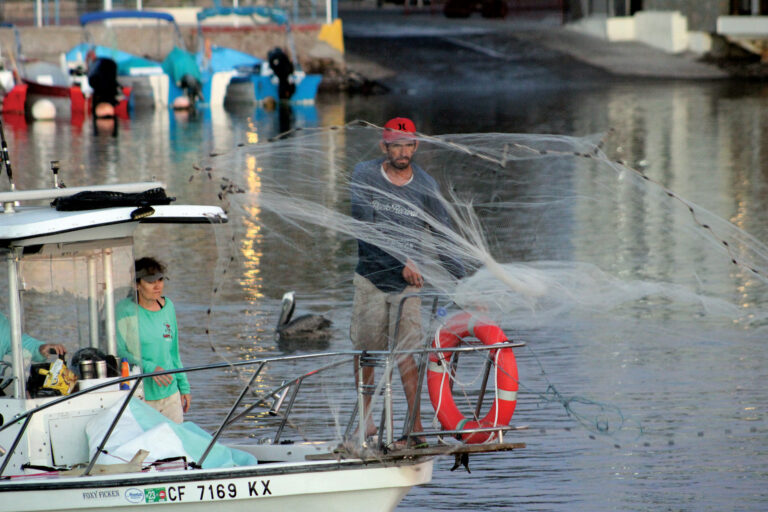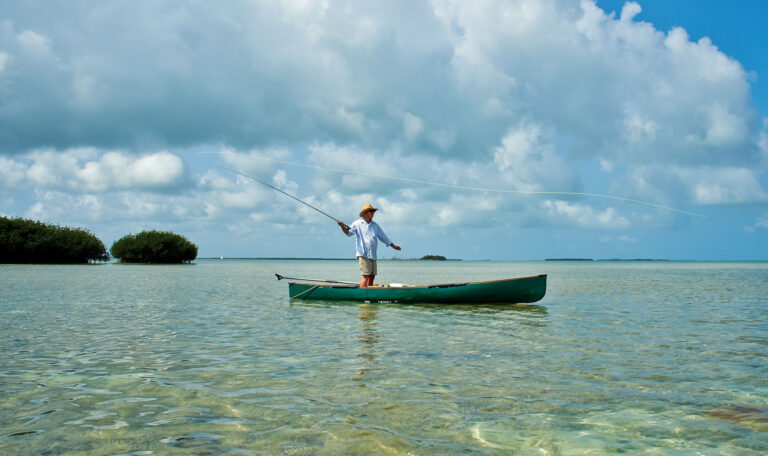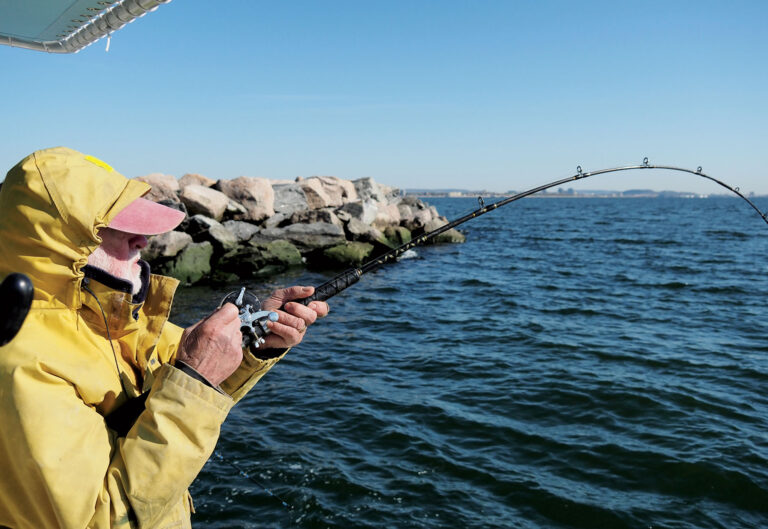It was a hot, sticky, dark evening. The cicadas clamored away, and a fishy smell wafted over the marsh. I heard the commotion of feeding fish before I saw anything. I shined my headlamp on the water and watched hundreds of bizarre red-and-black worms swirl in the light.
I’d heard stories of people catching striped bass during worm hatches but had never stumbled upon one. Needless to say, I was not prepared. I rummaged through my fly box, and the only thing that came close to imitating this mass of frantic worms was a 6-inch black-and-red Clouser I had tied for wahoo. I quickly cut it back to 3 inches, slightly larger than the worms.
I cast and stripped my fly the way I typically fish for stripers — moderately fast and steady, with 8-inch strips. I did this a dozen times without a bump as the fish continued to swirl and slurp all around me. To add to my frustration, my line knotted up during a cast, and the fly sank to the bottom as I worked to untangle the mess. I took two slow strips to pull the fly off the bottom, hoping it wouldn’t snag, and my line suddenly came tight on a fish. That’s more like it.
Since that night I have been addicted to fishing worm hatches for striped bass. Trust me, there’s nothing quite like it in the salt.

Another season is upon us in the Northeast. The stripers are back, and rising temperatures will soon trigger cinder worm (Nereis limbata) hatches in estuaries from the Mid-Atlantic to New England. These strange worms — ½ inch to 4 inches or longer and red, maroon, tan or olive, with dark heads — emerge by the millions from muddy bottoms to spawn, after which they die.
Most people who fish stripers never see this phenomenon because it usually occurs after dark — there are exceptions — in salt ponds, marshes, tidal rivers and bays. Timing the hatches is tricky, and you have to put in some long hours to figure things out.
“You just need to get out there and get wet and do it,” says Capt. Jim Barr, a worm veteran and saltwater fly guide who owns and operates Skinny Waters Charters in Newport, Rhode Island.
“Tootsie Rolls for Bass”
If striped bass are your thing, fishing a worm hatch might be as intense an experience you’ll encounter. It is for me. Across the Northeast, many of us await this bite all year.
No two spots are alike, and the sudden appearance of worms is dependent on a number of variables, such as moon phase, water and air temperature, tide and current, and a host of other factors. In general, warm days with big tides heat the mud flats and trigger spawning. When conditions are right, clouds of these little morsels suddenly emerge from nowhere in coves and tidal creeks. Just about anything that swims, crawls or flies eats these invertebrates, but striped bass in particular seem to relish vacuuming them up. Saltwater fly-fishing guide Capt. Bob Hines calls them “Tootsie Rolls for stripers.”
On a calm evening, raindrop-like dimples ripple across the surface film. “It’s the closest thing to dry fly-fishing in salt water,” says Hines, owner of Fly Fish Rhode Island, who has been fishing worm hatches for more than 30 years. Hines still remembers the first hatch he witnessed. “I was in complete awe,” he recalls.
In the Rhode Island salt ponds, the hatches often start in midafternoon rather than after dark, which can make for exciting action. “It’s so visual,” says Hines. “I’ve seen fish cruising on top, sucking in worms, and had clients lead them as if they were fishing to a tarpon and hook up.”
On a good night you can take a dozen or more fish — mostly schoolies between 16 and 32 inches, and weighing as much as 15 pounds. Larger fish are known to hoover-up these snack bites, as well.
 Stripers slurp spawning worms as the sun sets over a Rhode Island salt pond, where Capt. Bob Hines is guiding a client. Photographer Barry Beck caught the action.
Stripers slurp spawning worms as the sun sets over a Rhode Island salt pond, where Capt. Bob Hines is guiding a client. Photographer Barry Beck caught the action.Capt. John McMurray, who has been guiding anglers to hatches in Jamaica Bay, New York, for about a decade, has seen cow bass grazing through meadows of spawning worms. “When I first moved down here and started fishing hatches, we used to have hatches where there were 40- and 50-pound [striped bass] just rolling through them,” recalls McMurray, who runs One More Cast Charters.
A word of warning: Fishing a worm hatch can be an exercise in frustration, especially if the hatch is heavy. It’s the proverbial needle-in-the-haystack principle. More worms hurt the odds of your fly or lure being whacked. Fewer worms mean less competition and a higher likelihood that your bait gets noticed. As a rule of thumb, worm densities are lighter two or three days before a moon. Think of it as the Goldilocks method — not too many worms, not too few.
Techniques
I can tell you from experience that it’s not easy to keep your head straight when fish are swarming and slurping all around you, and you can’t get one to eat your fly. It’s driven people mad.
Hines remembers early frustrating encounters with stripers feeding on worms and turning a blind eye to everything else. “I have all these bass around me, and I threw every fly I had in my box, and I couldn’t feed a fish,” he says.
Fly-fishing is one of the most effective ways to target stripers on a hatch. It gives you the ability to present small, realistic, lightweight flies at the proper depth. Anglers typically use 7- to 9-weight rods, and floating and intermediate-sinking line.
I know more than a few dedicated anglers, myself included, who have spent years developing fly patterns to both imitate and stand out from the size, shape, color and movement of the worms in their home waters. Red and orange patterns have proved most effective, although there are exceptions. I also like to connect my fly or bait to the leader with a loop knot to help accentuate its erratic movement, like that of the worms.
Although the majority of anglers who fish hatches use fly rods, spinning set-ups with light braid also can be effective. Hines and Barr have put plenty of spinning clients into fish. They use a simple rig consisting of a plastic bobber weighted with water for casting. Trailing off the end of the casting float on a short length of mono is a cinder worm fly or small, soft plastic bait in some variation of pink, gray or olive.
Whether you’re fishing fly or spin, the retrieve must be painfully slow to imitate the bait. In many spots, worms hatch in tidal marshes and are swept downstream on a falling tide, where stripers lay in wait. A dead drift with a fly or small artificial bait is an effective method for working these outflows.
 Spring action: stripers and cinder worms, depicted by artist Nick Mayer.
Spring action: stripers and cinder worms, depicted by artist Nick Mayer.Another tip: When the size and color of the worms in a hatch vary significantly, Hines will often fish two flies at once, using different patterns or colors to increase the chances of a hook-up.
Night fishing for striped bass pushes you into an altered state, where you feel as if you’re in a trance, yet fully alert to everything around you. Without the luxury of sight, you cast to breaking fish by sound. A slow-crawl retrieve is most effective. I use 6-inch strips every three seconds to keep my fly in the strike zone. It’s crucial that you remain focused and in touch with your line. My line has come tight between strips many times and has nearly been pulled from my hand by a hot fish. There is no greater rush than fishing a night hatch.
Sleuths
Finding a cinder worm spawn is part art, part science, with a little magic thrown in. Depending on where you fish, you’ll encounter plenty of variation in the timing of hatches. A hatch window may be as narrow as a couple of hours or less, which makes preparation critical. Depending on the area, spawning might end in June or continue into August.
A successful devotee of the hatch learns to become meteorologist, biologist and sleuth. You have to keep an eye on the moons and an ear to local fishing chatter, and venture out on scouting forays as often as possible.
For me, it’s as much about the hunt as it is about catching fish. In Connecticut, where I do much of my fishing, most worm nuts start to search several days prior to and after the new and full moons. They scour mud flats that have a history of action by boat and car until they find feeding fish.
Although I’ve fished hatches in neighboring states, my home fishery has some of the most prolific and consistent action. It also helps if you’re a night owl. In the Norwalk Islands of Connecticut, for example, hatches take place between 10 p.m. and 3 a.m. from May to August. The formula is simple: hot and sunny days, warm water, light winds and big moon tides.
 A nice striper fell to a worm pattern in a Rhody salt pond that has daytime hatches.
A nice striper fell to a worm pattern in a Rhody salt pond that has daytime hatches.Nuances
McMurray says there are huge hatches in Jamaica Bay within a stone’s throw of the lights of New York City. Ideal conditions there are much the same as those in Connecticut. “When they do hatch, it’s epic,” McMurray says. “There’s thousands and thousands of worms.”
Although cinder worm imitations seem to work well in most places, McMurray has found greater success by not trying to match the hatch. High-calorie meals are the ticket here. He prefers to throw large black flies with lots of feathers and large Edgewater foam popper flies. When spin-fishing during a hatch, McMurray uses something big. “Large black Slug-Gos worked super-slow, or a 6- or even 8-inch black Bomber,” he says. You get a lot of looks, follows and refusals, but when it comes together, hold on.
Rhode Island is another story. The hatches in the shallow salt ponds take place from May to mid-June, usually between 3:30 and 8:30 p.m., which makes them unique. Hines and Barr work together to find worms early in the season by keeping track of water temperatures so they can anticipate spawning. Though temperatures are important, the Rhode Island hatch is also a visual game played during daylight hours.
The Ocean State’s expansive network of mud-bottom coves requires anglers to become detectives, tracking down the spots with the most favorable worm-to-fish ratios. Hines has found that the early hatches typically occur in the coves farthest from ocean inlets, through which colder water pours into the ponds. As the season progresses and temperatures even out, the hatches shift toward the pond mouths. The daytime aspect makes Rhode Island salt-pond fishing unique.
 On the prowl in the shallows.
On the prowl in the shallows.Bedtime
It is the dead of night, and I’m exhausted from fishing a phenomenal new-moon hatch, but my mind is still tuned to any sound. The splashes of feeding fish, thankfully, have mostly subsided. I catch myself going back over the last few hours in my mind.
It’s never about the grip-and-grin or the fish count. For me, it’s always been the hunt, and tonight the search for worms and stripers has been successful. The only sound I hear now is that of my legs pushing slowly through the water as I head for my truck.










